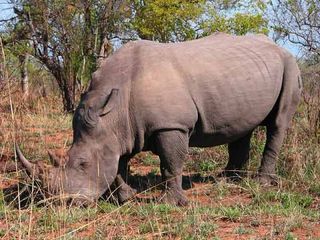Species Success: Rhinos Recover

After nearly disappearing from the planet, African white and black rhinos have made a healthy recovery, according to a wildlife advocacy group.
In the 1990s, these species had been poached almost to extinction for their valuable horns. But thanks to anti-poaching efforts, as well as the cooperation of local communities, African rhinoceros populations are on the rise.
"We have seen an increase in rhino populations of at least five percent per year over the last decade, which is encouraging," said George Kampamba, coordinator for World Wildlife Fund International’s African Rhino Program.
In 1997, there were 8,466 white rhinos and 2,599 black rhinos living in the wild. Today, there are 14,500 white rhinos and nearly 4,000 black rhinos.
"There's been a healthy increase in rhino numbers," said Petra Fleischer, fundraising manager of Save the Rhino International. "It’s the combined effort of anti-poaching work and monitoring to get a better picture of populations, environmental education, government strategies and community involvement. International funding is important, too." Fleischer said getting local African people involved has been critical.
"It's important to work with local communities to find opportunities for generating income through conservation, such as through tourism," Fleischer told LiveScience.
Rhinos have recently been reintroduced to some countries where they had disappeared, such as Zambia and Uganda. This can help motivate local people to become more involved in conservation, and can give a boost to tourism, Fleischer said.
Sign up for the Live Science daily newsletter now
Get the world’s most fascinating discoveries delivered straight to your inbox.
Rhinoceroses are huge creatures — adults often weigh more than a ton — and they can live to age 60 or older. They are herbivores, subsisting mostly on leafy greens.
Both types of African rhino have two horns protruding from their snouts. Rhino horn is a common treatment in traditional Asian medicine, which keeps demand high. Rhino horn dagger handles are also very popular in Yemen. Habitat loss has also been a problem for rhinos.
Black rhinos, smaller than their white relations, are more endangered. Three of four black rhino subspecies are classified as "critically endangered" by the World Conservation Union.
"White rhinos are this amazing conservation success story," Fleischer said. "Black rhinos are still critically endangered so we still have lot of work to do."
The World Conservation Union now classifies white rhinos as "near threatened."
Along with African rhino species, there are three species of Asian rhinoceros, two of which are also critically endangered.
- Top 10 Species Success Stories
- Success Stories: Species on the Rebound
- Image Gallery: Endangered and Threatened Wildlife
Most Popular




